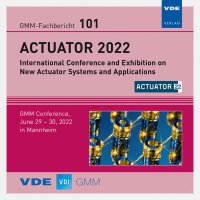Disc Type Piezoelectric Actuator for Optical Lens Positioning
Konferenz: ACTUATOR 2022 - International Conference and Exhibition on New Actuator Systems and Applications
29.06.2022 - 30.06.2022 in Mannheim
Tagungsband: GMM-Fb. 101: ACTUATOR 2022
Seiten: 4Sprache: EnglischTyp: PDF
Autoren:
Mazeika, Dalius (Nanjing University of Aeronautics and Astronautics, Nanjing, China & Vilnius Gediminas Technical University, Vilnius, Lithuania)
Vasiljev, Piotr; Bareikis, Regimantas; Borodinas, Sergejus (Nanjing University of Aeronautics and Astronautics, Nanjing, China & Vytautas Magnus University, Kaunas, Lithuania)
Yang, Ying (Nanjing University of Aeronautics and Astronautics, Nanjing, China)
Ceponis, Andrius (Vilnius College of Technologies and Design, Vilnius, Lithuania)
Struckas, Arunas (Vytautas Magnus University, Kaunas, Lithuania)
Inhalt:
The paper presents a novel inertial piezoelectric actuator developed for optical lens positioning and autofocusing function with high resolution. The actuator comprises a bimorph piezoelectric hollowed disc and carbon fiber tube with three fixing points used to glue the tube on the top surface of the bimorph disc. A ring-shaped slider is mounted on the tube and moves the optical lens along the axial direction of the tube. Electrodes of the disc are divided into six sections and grouped into two groups. Two sawtooth or square waveform electric signals with the phase difference of π are used to drive the actuator. The operation principle of the piezoelectric actuator is based on the excitation of B03 out-of-plane vibration mode of the bimorph disc. Asymmetrical vibrations of the bimorph disc are transferred into vibrations of the carbon fiber tube in the axial direction and inertial displacement of the slider, respectively. The numerical investigation of the actuator was performed to validate the operation principle of the actuator and to indicate the mechanical and electrical characteristics of the actuator. The prototype of the piezoelectric actuator was made and experimental measurements were performed. The maximum linear speed of 20.61 mm/s and thrust force of 0.18 N was obtained when the voltage of 60 Vp-p was applied.


